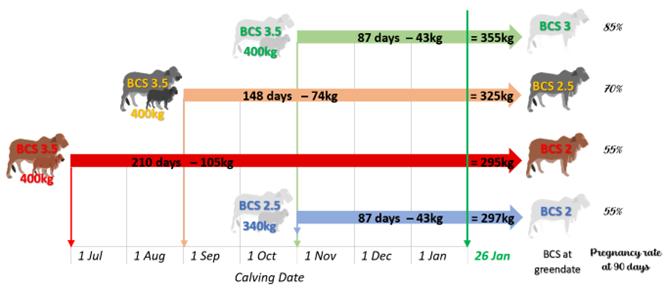Preparing for the double whammy nutrition effect: part two
Every dry season we are hit with the double whammy nutrition effect, of declining nutrient levels and digestibility in pasture. If you missed this article, click here to find out more. In summary, pasture quality is low and cattle are eating less of it! This results in a large nutritional gap for many classes of stock. There are several strategies to prepare for the double whammy, which will minimise production losses and supplementation costs.
1. Understand the nutritional requirements of different classes of stock
The nutritional needs of dry growing cattle are very different to wet cows. It is critical to know what an animal’s requirements are, to determine their nutritional status. Figure 1 below outlines how the nutritional requirements of a breeder change throughout the year. More information on nutritional requirements can be found here.

2. Time of calving
The earlier a cow calves in the dry season, the longer the period she has on poor quality pasture while her nutritional requirements are at their highest (Figure 1). This results in large live weight loss (up to 0.5kg/day), reduced BCS and lower conception rates at the next mating. Plugging the nutritional gap over long periods with high cost energy supplements is not profitable.
The closer a cow calves to the green date, the shorter the time on poor quality feed, resulting in a lower the nutritional deficit, less potential weight loss, and a higher chance of falling back in calf (Figure 2). Find out more about the nutritional management of breeders here.
3. Breeder body condition score (BCS) at calving
Breeder body condition score at calving has a direct correlation with conception rates. The higher a cows BCS at calving, the more body condition reserves she has to lose after calving, whilst still remaining in high enough condition to re-conceive in the mating period. For year round mated herds, cows that calve in good body condition have more timely re-conceptions.
Figure 2 below demonstrates the difference in conception rates of two cows calving at the same time, in different BCS.

4. Segregating animals based on their nutritional requirements
Segregating stock into groups based on their nutritional requirements is an effective way to target your supplementation program and reduce costs.
Segregating breeders into calving groups is a valuable strategy for year round mated herds and herds with long calving periods. Cows that calve early in the dry season face the greatest nutritional challenge. Segregation enables more effective management of supplementation and weaning.
5. Sensible supplementation
With the above strategies considered, a supplementation program can be tailored to ensure the right animals are getting what they need at the right time, to minimise their nutritional deficit.
This article details all the considerations for a supplement feeding program.
While supplementation is a great strategy to deal with the double whammy effect, for a breeder operation, supplementation alone is not a profitable strategy for producing a calf every year. Understanding stock nutritional requirements, timing calving close your green date, ensuring high BCS at calving and segregating into groups are all essential management strategies to prepare for, and minimise the double whammy nutrition effect.